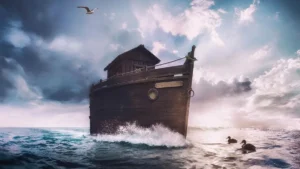
Floods are inconvenient. It has meant that our car is marooned in Tasmania, contradicting my statement that we are physically confined to this island: before the extreme weather, it has been a beautiful Spring. In Wynyard, there were beds of tulips along its streets and on Table Cape nearby, there was a proliferation of tulips set out in long multicoloured rows. We purchased a pot with a ruby red tulip in full flower which was added to the cut rhododendrons and camellias already dotted around the house. The azaleas were coming into bloom at the back door. The silver wattle is in full bloom, a blaze of colour from the dining table.
The native waratahs are also in full flower. So is the pink heath; and the intersection of the native and exotic just reminded us of how beautiful October can be in Tasmania – even if one turns a blind eye to the uncontrolled spread of the yellow gorse curse on the road out of Zeehan. Beautiful at a distance; an evil thorny infiltrate close up.
Then the rain, as predicted, came and flooded among many other places in that part of the State, the Meander Valley, as it did six years ago. At that time the Huon valley in the south was also severely affected. Now in October 2022, the flooding has been concentrated in the Meander Valley to the west of Launceston, and the alongside coastal Latrobe area.
It had rained in Strahan where we were, but then it always rains there. The last week, it had been sunshine and barely any rain. But the rain was tossing down as much as 30 cm every 24 hours into Meander Valley settlements and other nearby townships. Flood mitigation works which had been promised after the last flood had not been commenced in the Meander Valley. Despite the Report following the last flood, which recommended inter alia “While it ‘may be’ that State and Local Government under-invests in flood mitigation, a lot more work is required to understand whether measures such as additional flood levees are appropriate.” – a very curious circumlocutory way of saying that nothing had been done. Such word calisthenics should never be part of a Report seeking urgent improvement on what had been shown to be the dire situation in 2016, only six years ago.
The word surreal is overused and often incorrectly used to describe extraordinary situations. After we were informed that the car ferry sailings had been cancelled indefinitely from Devonport to Melbourne, first because the flooded Mersey river has caused the ferry to float higher than the wharf which made it impossible for vehicles to board, not only cars, but trucks up to the size of B-doubles; and second because of the dangers posed by sunken boats as Devonport lies at the mouth of the Mersey River, which has been one of larger contributors to the flood.
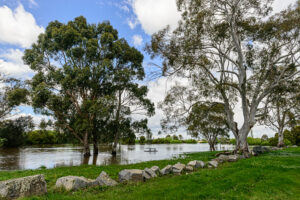
Yet one piece of foresight has been the placement of the Bass Highway between Burnie and Launceston. At times, close to the pavement, we passed torrents of water, not just passive sheets of water, but swiftly flowing rivers broken up by wavelets which had broken their banks and the countryside, almost has far as the eye could see, was water engulfing fences and trees. On the edge of these areas, cattle had been unloaded to what was considered higher ground, and only in very small areas was there evidence of the flood ebbing – exposing the mud which will coat the landscape, whether field or town, for weeks.
And yet here was the Bass Highway, at no stage covered with water nor even any warning signs – all the way to Launceston and out to the airport, where we dropped our guest from America. Given she had committed herself to a nationwide tour the following week, it would have been very inconvenient if she had been unable to fly back to Sydney – hence the introductory sentence.
As for ourselves, the car ferry has resumed this week. We found satisfactory accommodation; we have friends in Hobart to leave the car with until we are able return sometime in mid-November. We are privileged because the privileged always have options. But those without have a forced sojourn in Devonport, and an unpleasant addition to the costs. That is the real problem of these new phenomena of extreme weather – little emergency accommodation – a worthy matter to be considered when considering regional grant programs and of more value to the community than subsidising, for instance, a paper mill in Tumut, which the billionaire owner was well able to afford, even without scattering a few canapés around a troop of generous politicians.
Meandering towards a Government Font
We have driven through the floods in northern Tasmania albeit along the Bass Highway as related above.
The following comment was written prior to the floods, but it illustrates a phenomenon not just restricted to this Council.
Sometimes one gets insights by casually reading an item in the local newspaper. A complaint has surfaced about money which had been allocated by the previous Federal Government through its regional grants program, namely $3.35 million allocated to the Meander Valley community “to contribute to the redevelopment of this area (Deloraine Racecourse)”.
This grant, allocated by the previous government, should be honoured by the Federal Government according to Senator Colbeck, who himself was once the Federal Minister for Sport. Senator Colbeck is reported as having said that “this is a commitment that has some standing over a matter of time and is not from before the last election, it goes back to 2019, and frankly the community doesn’t care who it comes from” and “we don’t want any mean and nasty politics where they could say ‘due to it being made by the opposition we’ll reconsider it or take it away’ and that the community has been planning on the basis of the commitment”.
Senator Colbeck has, in recent consultations with the Meander Valley mayor, discussed the impact of the potential cut in funding. He has called on the Labor Member for Lyons, Brian Mitchell, to “stand up” to the Government because the community is deserving of the funding.
The Deloraine racecourse has been closed since 2005 because it did not meet occupational health and safety requirements. The time-honoured Deloraine Cup was moved to various other racetracks. The Deloraine racecourse is located on the edge of Deloraine. The mayor has said “the funding would help the Council bring new life to one of Australia’s oldest existing racecourses by turning it into a regional-scale community space. I haven’t heard of anyone against these upgrades and there’s no real limit to what we can do here, we just need some dollars to get some facilities up”.
It so epitomises how much of the money was splashed around by the last Federal Government under vague generic titles. There is nothing in this report to say that they have any pressing need for it and in fact, being so close to town, presumably the land could have been subdivided to provide space for housing – even desperately needed social housing. However there is no mention of what the local council was prepared to use the money for, including in terms of any major development such as the words “community facilities” foreshadows.
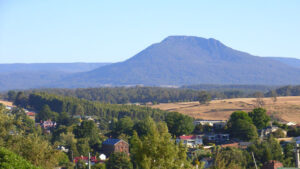
Meander Valley Council extends from the edge of Launceston to The Grand Tiers, the wilderness area where the Walls of Jerusalem are located. The population of the whole area is about 20,000 and that of the township of Deloraine is 3,000. There are already ten recreation grounds in the Council area, but why worry about the odd $3m. May I suggest that giving $1,000 to each of the inhabitants would probably be just as valuable as funding a number of well-catered planning meetings coupled with interstate and overseas fact-finding missions determining what to do; and handing over to a “consultant” to provide the ultimate “pie in the sky” report for the Council. That would just about cover the $3.2m.
But my wife looked at me and said that I’m complicating the rationale and putting on my own devious spin on what was a few worthies wandering into the nearest political ATM with their request – they would like to renew the Deloraine racecourse and return the Deloraine Cup to its rightful place for the one day of the year, with numerous plaques acknowledging the works of these worthies place everywhere. However, for the sake of appearances better to have the application state “community facilities”
If the objective is achieved and the Cup returned for the one day of the year, where is the money to maintain this putative achievement – maintaining racecourses where the eponymous cup is the only reason to keep them going. By the way, why do those writ large on plaques need to confront the local populace with the cost to maintain such a little used facility?
Yet it is all a bit superfluous given what has happened in the past week. Anyway, that grant may be axed in the forthcoming budget, along with a number of other pending grants. I would have thought that any funding asked from a regional grants program would have been better used as part of flood mitigation, and viewed as same. But this is just using hindsight to criticise a worthy objective, my critics would say. The social, environmental and economic impacts of the 2016 floods in Tasmania were significant, affecting 20 local government areas with an estimated damages bill of $180 million. One bizarre comment from a mayor of another municipality was that one of the real problems was that the 2016 floods had come in darkness. Really, it should not matter of the time of the day in a well warned, well prepared community.
The Tasmanian Recovery Plan published in 2017 was strong on what had to be done to respond to flood rather than prevention of same. Mention was made of the Meander Dam opened in 2007, but that clearly has been insufficient to halt flooding.
The Tasmanian Ports Corporation has responsibility for the eleven Tasmanian ports (as well as the Devonport airport). After the 2016 flood, it has made progress in levelling the seabed at Devonport, and the ferry departure from Devonport now is scheduled three and a half days after its cancellation. In 2016, it took six days then, and people were reported as sleeping in their cars. I understand this is not the case this time.
The communities in the Mersey River catchment do not have that luxury for such an improved response. Maybe I am missing something, but a grants program at any level should have a utilitarian aim, while protecting the rights of the minority.
After this flood has ebbed and the communities have removed the mud and calculated the water damage, perhaps the next plan, in a timely response to this disaster, should include prevention in its title.
It is somewhat ironic to realise that the Latrobe Council next door to the Meander Valley Council has been working on its flood mitigation for six years, whereas Meander Valley has just commenced its flood mitigation works. A projected cost of $14m equally shared by the three tiers of government. As stated: This project will see the construction of levees around Latrobe’s south–western and southern perimeter as well as a flood gate structure (lower Kings Creek) and a peak–flow flood diverter on Kings Creek at Kings Park. The levee system is designed to prevent Mersey River and Kings Creek floodwaters from entering the town’s central business district and nearby residential areas during a significant flood event and provides a temporary water storage area for local runoff behind the walls until flood levels outside the walls reduce.
It sounds impressive, but it is still far away from completion. The cause of the delay? Determining the habitat of the central north burrowing crayfish. Here is certainly a case of protecting the rights of the minority.
Flooding – a personal reflection
My first experience of a flooded living area was in the 1960s where the top floor of the house in Parkville we were partially renting, suddenly showed the ravages of having a frugal owner. The roof began leaking during a particularly violent storm and the staircase became a waterfall. We left immediately in our sodden state. Fortunately it was in an early impecunious period and we had few belongings, but we did have a young child. “Negotiating Niagara holding onto a banister holding a baby with the other was no fun.” Her comments were an exercise in understatement.
The second occurred in the early 1980s in the cottage which we had purchased in Balmain. The cottage was on the side of a steep hill, as many of the suburbs surrounding the Harbour are. In the space of two years, there were two episodes of storms dumping in excess of 20 centimetres of rain over Sydney. Each time the house was flooded to somewhere close to a third of a metre. The major problem was that the water was not seeping under the doors, but coming up the drain in the bathroom like a fountain.
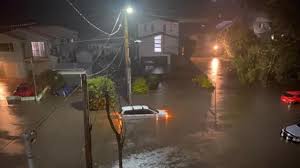 Sandbagging the back bedroom did not work, and we tried to move as much stuff as we could off the floor. Fortunately the bed was raised on a platform and was barely affected. The carpets were ruined as were some smaller items, which could not be recovered. On the second occasion we gave up and retired upstairs with a bottle of bourbon. Added to this, we had episodes of the office being flooded, due to its being the lowest lying office in a building built at the bottom of the conjunction of a number of streets and again, lacking any effective flood mitigation. Thus when I see people whose houses have been fully submerged – if not washed away – I just cannot understand how these people cope, especially when it has occurred on multiple occasions.
Sandbagging the back bedroom did not work, and we tried to move as much stuff as we could off the floor. Fortunately the bed was raised on a platform and was barely affected. The carpets were ruined as were some smaller items, which could not be recovered. On the second occasion we gave up and retired upstairs with a bottle of bourbon. Added to this, we had episodes of the office being flooded, due to its being the lowest lying office in a building built at the bottom of the conjunction of a number of streets and again, lacking any effective flood mitigation. Thus when I see people whose houses have been fully submerged – if not washed away – I just cannot understand how these people cope, especially when it has occurred on multiple occasions.
In one way my experience verges on the insignificant; but unless you have experienced the helplessness of not being able to prevent water coming into your existence, it is hard to comprehend. Whether Australia will wake up and insulate itself against natural catastrophe in the uniform way that our Federation has generally found itself able to do is yet to be seen. A national approach where the common good prevails would be a novelty, especially if not labelled “socialism” – a sure way to kill any community approach.
There are always going to be the foolhardy. Do we need to work out an index for the expected number of foolhardy people who will need scarce resources for their rescue or do you warn them that nothing can be done– that over a certain level personal responsibility allowed for “dickheads”, in that imagined World of “personal responsibility”, these people would be left to their own resources.
However, that does not occur, because the majority of the community are prepared respond to the foolhardy predicaments – to accept responsibility on behalf of the community in which we all have a place.
… Spare the Horses
Floodplain management is coordinated by Council’s Infrastructure Planning team within the Footpaths, Roads, Traffic and Stormwater Group. Inner West Council, and its predecessors, has been undertaking flood risk studies across the 9 primary catchments within its LGA since 2009 in accordance with the NSW Flood Prone Land Policy. The policy specifies a staged approach to the floodplain management process.
This is how my local Council is avoiding its obligations. How many Councils are guilty of such reassuring puffery telling its rate payers that it has done nothing of significance beyond endless planning?
Much has been made of the flood wall built by the Victorian Racing Club in 2007, when the then responsible planning Victorian State Minister overturned the bid by the City of Melbourne, and Maribyrnong and Moonee Valley councils, to block it.
The Maribyrnong River commences on Mount Macedon and wends its way 160 kms down to its mouth in Port Phillip Bay near Yarraville. The Flemington Racecourse, where 26 race meetings are held each year and which is home for 600 horses in the stables of 30 trainers was constructed on the Maribyrnong River flood plain.
The basic facts set out in Wikipedia about the racecourse itself are: … comprises 1.27 square kms of Crown Land. The course was originally leased to the Victoria Turf Club in 1848, which merged with the Victoria Jockey Club in 1864 to form the Victoria Racing Club. The first Melbourne Cup was run in 1861. In 1871 the Victoria Racing Club Act was passed, giving the VRC legal control over Flemington Racecourse.
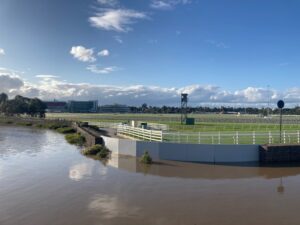
In Melbourne, interfering with the Melbourne Cup is tantamount to interfering with Christmas. Nevertheless, this is not any solace to the 260 residents who were flooded by water allegedly banked up by the flood wall. Some insensitive comments from a former executive of the VRC did not help. Nevertheless, it should be noted that the wall went up in 2007, and government has not done anything about a flood mitigation program in the past fifteen years since the wall was built.
Australia’s problem is its addiction to gambling which is beyond going into any rehabilitation program while government needs the revenue to bolster its bottom line – a tax on those who can least afford it. Here the needs of flood mitigation collided with the gambling behemoth – one of the major contaminants within its “Victorian Catchment”.
This space will be interesting to follow since the recent disaster aggravated by the Racing Wall lies in Bill Shorten’s electorate, and his constituency not being in the champagne tents on the first Tuesday in November, may result in rectifying a situation which has been threatening ever since the VRC divorced itself by The Wall construction from its community.
So in the end, climate change makes so much of the “one in 50 years occurrences” predictions so much malarkey. Governments should hold their breath, forget Australia will have periods of apparent drought, but what is required is identification of places like Lismore which will flood repeatably and accept that the town is in the wrong place, and not depend on Sisyphus to determine our national policy.
Pounamu (Greenstone) – to a Full Memory
 One of my most prized possessions in a mere made of pounamu. Pounamu is the Maori word for greenstone. Greenstone is nephrite jade. Jadeite, more common in Chinese ornamentation is a lighter green. The most basic difference between jadeite and nephrite, the two forms of jade, is that despite both being silicates, the minerals found in each are different. Jadeite is composed of silicates of aluminium and sodium, whereas nephrites are silicates of calcium and magnesium.
One of my most prized possessions in a mere made of pounamu. Pounamu is the Maori word for greenstone. Greenstone is nephrite jade. Jadeite, more common in Chinese ornamentation is a lighter green. The most basic difference between jadeite and nephrite, the two forms of jade, is that despite both being silicates, the minerals found in each are different. Jadeite is composed of silicates of aluminium and sodium, whereas nephrites are silicates of calcium and magnesium.
Pounamu is found in the South Island in deposits known to the indigenous people. On the wild spume-laden windy beach at Hokitika, I remember the pieces of pounamu in all its shades of deep green mingled with so much magnificent driftwood. The pounamu comes down the Hokitika river which rises in the Southern Alps and gets its turquoise colour from its glacial origin and the flakes of stone called “rock flour”. By the time it flows into the Tasman Sea, it is a muddy jade in colour. Pounamu is deep emerald, with slashes of green so dark, a casual observer would say it is black.
When I became President of the Australasian Faculty of Public Health Medicine, one of my tasks was to convince the New Zealanders that I was serious about the New Zealand contribution; and recognise that New Zealanders were not Australians. The New Zealanders and Australians have superficial similarities with Australians in language and Anglo-Celtic colonisation.
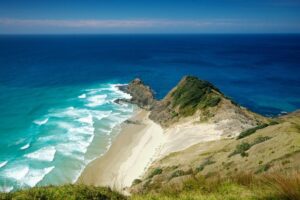
The problem is that the similarities create the illusion of delusion unless confronted, which I did by actually asking to be educated rather than socialised into a different society. During my three years, I visited New Zealand at least twice a year, generally in February and August. I add I am not a skier, so the time in the wintry New Zealand was certainly not spent on the slopes. Early on, I had met John McLeod. He had been a public health physician with not inconsiderable presence. He was a Ngä Puhi, his iwi or Maori community being located in the very North of the North Island embracing Cape Reinga, the most northerly point where the deep blue Pacific Ocean meets the aquamarine Southern Ocean.
So, I was a pakeha, so what! Our friendship grew from there.
I asked whether he could get me a very good mere, which he did. The mere is a Maori weapon – a hand club, and he provided me with an elegant amokura made from the kawakawa (dark) variety of pounamu characterised by “black” flecks, which to me still have a green basis. To me it symbolises one person’s acceptance of an Australian trying to understand New Zealanders aspirations. It cemented the succession planning of John to succeed as President. Unfortunately, in 1994 John was killed in a head on collision in the North Island returning home from his bach. A terrible, terrible loss given that my successor undid much of what we had crafted in the first six years with Sue Morey being the inspirational first President.
At least having the mere, I have never forgotten John McLeod, and what could have been.
Mouse Whisper
Given all this flood talk, I could not help myself from joining in with a comment about the Noah malarkey. It does not take a genius to realise how scientifically impossible was an Ark containing a brace of every item of fauna. And as for the flood, some person who had too much time on his hands calculated the following:
There had to be 813,875,076 miles³ of rain for the biblical flood. To put that in perspective, the oceans have about 321,000,000 miles³ of water. All the water on earth only adds up to about 332,500,000 miles³. So for the biblical flood to have happened, the water on earth had to miraculously multiply by about 250%.
The people who believe literally in Noah and his Ark are the same people who believe in the Trump election win.
